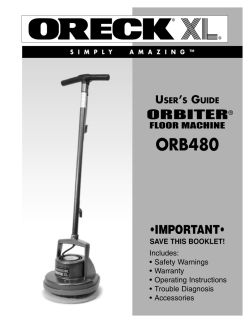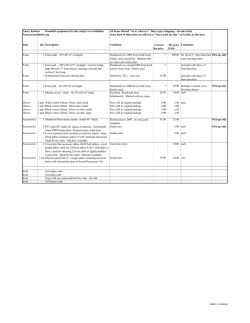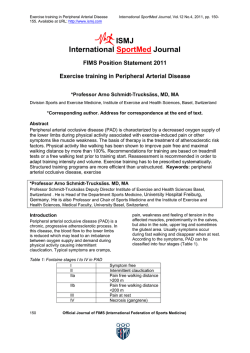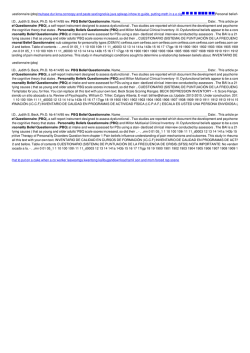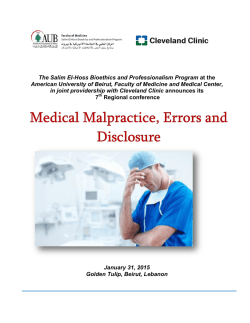
Legality and age influence end of life decisions in - edigraphic.com
ARTÍCULO ORIGINAL Legality and age influence end of life decisions in Mexican physicians Alvar Loria,* Cynthia Villarreal-Garza,*** Erika Sifuentes,*** Rubén Lisker** *Unidad de Epidemiología Clínica, **Dirección de Investigación, Instituto Nacional de Ciencias Médicas y Nutrición Salvador Zubirán. ***Departamento de Oncología Médica y Tumores Mamarios, Instituto Nacional de Cancerología. ABSTRACT Purpose. To test in two groups of physicians-in-training a simplified questionnaire exploring their acceptance of Physician Assisted Death (PAD), Therapy Withdrawal upon family request (WD), and Personalized PAD (PPAD) on whether the participant would seek PAD for him/herself. Material and methods. A 4-item questionnaire was answered by 212 residents in different stages of training and grouped as beginners (1st and 3d year internal medicine residents, n = 76) and advanced (5th to 8th year residents of different internal medicine or oncology subspecialties, n = 136). The response options to the PAD and WD questions included a conditioned yes (CYes) dealing with legalization of PAD or the existence of a patient’s previous written agreement to WD. Results. Beginners had significantly more Yes plus C-Yes answers than advanced for questions regarding PAD (82 vs. 55%), WD (95 vs. 75%) and PPAD (76 vs. 56%). The importance of legal aspects implied in the conditioned answers can be seen in two findings: a) A sizable 29% of participants conditioned their Yes answers for both questions whereas only 9% gave an unconditioned Yes to both. b) A cross-classification of the PAD and WD answers showed that 13% of participants reversed their No in PAD to C-Yes in WD. Conclusions. Our simplified questionnaire operated well and was able to confirm the increase in acceptance of PAD and WD by young Mexican physicians, and the need of legislation regarding end of life decisions in our country. Key words. Physician assisted death. Therapy withdrawal. Mercy killing. Mexico. Medical students and residents. La edad y aspectos legales influencian las decisiones al final de la vida a mexicanos RESUMEN Propósito. Evaluar en médicos mexicanos la aceptación de muerte médicamente asistida (MA), descontinuación de terapia a petición familiar (DT) y MA personalizada (MAP) sobre si el encuestado la buscaría para sí mismo. Material y métodos. Se aplicó un cuestionario de cuatro preguntas a 212 residentes en diferentes fases de entrenamiento agrupados como principiantes (primero y tercer año de residencia en medicina interna: n = 76) y avanzados (residentes de quinto a octavo año de subespecialidades de medicina interna o de oncología: n = 136). Las opciones de respuesta a las preguntas de MA y DT incluyeron un sí condicionado (SíC) ligado a aspectos legales (legalización de MA y existencia de documento de voluntad anticipada en DT). Resultados. Los principiantes tuvieron significativamente mayor proporción de respuestas afirmativas (Sí + SíC) que los avanzados para MA (82 vs. 55%), DT (95 vs. 75%) and MAP (76 vs. 56%). Dos datos muestran la importancia de los aspectos legales: a) Un substancial 29% de los 212 participantes condicionó su Sí en MA y DT mientras que sólo 9% no lo condicionó. b) Una clasificación cruzada de las respuestas a MA y DT mostró que 13% de los participantes revirtió su No en MA a un sí condicionado en DT. Conclusiones. El cuestionario simplificado operó bien y confirmó el aumento de aceptación de MA y DT por médicos mexicanos jóvenes, y la necesidad de legislación en el área de las decisiones relacionadas con el fin de la vida. Palabras clave. Muerte médicamente asistida. Suspensión de tratamientos. Muerte por compasión. México. Estudiantes y residentes de medicina. i es i Clínica c / Vol. 66, Núm. 1 / Enero-Febrero, 2014 / pp 59-64 Revista de Investigación 9 INTRODUCTION In two previous studies, 1,2 we collected the opinions of several groups of Mexican medical students and physicians in regard to the acceptance of two scenarios that are common in medical practice: • Physician assisted death (PAD) where a physician agrees to the request of a terminal patient with intolerable suffering, to help him/ her die; and • Withdrawal of life support treatment (WD) when the family of a patient in persistent vegetative state asks the physician to remove all forms of treatment and let the patient die. One observation was that WD was accepted by a larger proportion of our physicians and students than PAD, and a second one was that the strongest factor favoring acceptance of PAD and WD was age with higher acceptance by younger participants. 1,2 Also favoring acceptance were an eventual legalization of PAD, and the existence of previous written consent for WD, whereas being Catholic worked against acceptance.1,2 The present study had two objectives: to test a simplified questionnaire of the one used previously 1,2 and to explore the acceptance of PAD and WD in other groups of physicians. MATERIAL AND METHODS Participants There were a total of 212 participants, all medical residents at two institutions: • Instituto Nacional de Cancerología (n = 61): advanced oncology residents that had finished a previous four year residency program, and were in their 5th to 8th year of residency specializing in diverse oncology areas; and • Instituto Nacional de Ciencias Médicas y Nutrición Salvador Zubirán (n = 151): 50 were first-year internal medicine residents, 26 in their third year, and 75 advanced residents. The latter had gone through a 4-year Internal Medicine residency and were in their 5th to 8th year of residency specializing in areas such as endocrinology, gastroenterology, infectious diseases, nephrology, and neurology. 60 Questionnaire It contained four questions: Q-1. PAD question. A terminally ill patient with in tolerable suffering and in full use of his/her mental faculties asks the physician for help to die. Would you agree? a) Yes. b) C-Yes (Conditioned Yes). Only if legalized. c) No, I would not agree even if legalized. If your answer to Q-1 is NO, please go to question 3. Q-2. Ways to help. How would you help him/her die? a) By therapy withdrawal. b) Prescribing a lethal medication or applying a lethal injection. Q-3. WD question. The family of a patient in Per sistent Vegetative State asks you to remove all forms of treatment and let the patient die. Would you agree? a) Yes. b) C-Yes. Only if the patient had a written state ment to that effect. c) No. I would not agree even if a written state ment existed. Q-4. Personalized PAD (PPAD) question. If you were in the last stage of a fatal disease and had unbearable suffering, would you ask for help to die? a) Yes I would. b) No I would not. This questionnaire differed from the one we used previously in several aspects: • The number of questions was reduced from nine to four. • We changed one of the three answer options substituting the “not sure” option with a “conditioned yes”; and • Shifted the participant’s role from spectator to performer, i.e. from “Would you agree with a physician helping...” to “Would you agree to help...”. v t Cl Loria A, et al. Legality and age influence end of life decisions in Mexican physicians. Rev IInvest Clin 2014; 66 (1): 59-64 Additional data such as year of medical residency, age, sex, religion and its importance in their daily life were collected but privacy was maintained by asking them not to include their name in the questionnaire. The study was approved by the Institutional Research Ethics Committee of the Instituto Nacional de Ciencias Médicas y Nutrición Salvador Zubirán. Survey It was performed during a two-week period of July of 2012. One of us (ES) applied the questionnaire at the end of a regular academic activity of the different residents’ groups. Each application was preceded by a brief explanation of the research purpose, and participation was voluntary. All individuals invited to cooperate agreed to this request. Statistical analysis The homogeneity of cell distribution in the tables was evaluated by χ2 testing, and group differences were established using the interval of confidence (IC95%) of the Odds Ratio: it was considered significant (p < 0.05) if the IC95% did not contain the null value of one. RESULTS The characteristics of the 212 participants are given in table 1 partitioned in two groups formed by pooling smaller groups that showed no significant intergroup differences in the proportion of answers to the four questions of the questionnaire. The pooled groups were: • Beginners (n = 76): 1st year (n = 50) and 3rd year (n = 26) internal medicine residents. • Advanced (n = 136): 5th to 8th year residents (61 from the Instituto Nacional de Cancerología and 75 from the Instituto Nacional de Ciencias Médicas y Nutrición Salvador Zubirán). Age was expectedly the only difference between beginners and advanced. There was a majority of males and Catholics, and a large proportion of the believers considered their religious beliefs were important or very important in their life. Table 2 shows the intergroup differences for answers to the questionnaire: Beginners residents had significantly more C-Yes or Yes answers than 1. Characteristics of the Beginners and Advanced Residents. Table 1. Variable Beginners n (%) Advanced Group differences * n (%) Age 23-28 yrs Age 29-36 yrs 71 (93) 5 (7) 14 (10) 122 (90) p < 0.05 Female Male 27 (36) 49 (64) 40 (29) 96 (71) NSD Catholics Another religion No religion 56 (74) 6 (8) 14 (18) 102 (75) 9 (7) 25 (18) NSD Importance of religion Very important Important Little importance No importance No religion 20 23 16 3 14 44 32 29 6 25 NSD Total 76 (100) (26) (30) (21) (4) (18) (32) (24) (21) (4) (18) 136 (100) *Age & gender differences evaluated by Odds Ratio method. Cell distribution of religion and its importance evaluated by chi square method. NSD: non-significant difference. the advanced for PAD, WD and PPAD, i.e. the sum of Yes + C-Yes answers in Beginners reached 82% for PAD and 95% for WD, whereas they were significantly lower in the advanced (55 and 75% respectively). The same table also shows that a Yes answer to the PPAD question was significantly more frequent in beginners than advanced (76 vs. 56%). It should be mentioned that similar differences were observed if age (< 29 vs. 29+) is used for grouping instead of training as 93% of beginners but only 10% of advanced, were aged below 29. In regard to the question on ways of helping to die, there were no group differences. Other variables such as gender and religion and its importance, did not reach a significant association with answers although Catholics tended to have less affirmative answers to PAD than non-Catholics plus nonbelievers (60 vs. 76%). We cross-classified the PAD answers with the WD answers and the crossings were classified in one of three categories: no change (same answer), minor change (from Yes to C-Yes or vice versa), and major change (from No to Yes/C-Yes, or vice versa). As shown in table 3, more than half of the partici- es Clinn 2014; 66 (1): 59-64 Loria A, et al. Legality and age influence end of life decisions in Mexican physicians. Revv Invest 61 l 2. 2. Comparison of answers of beginners and advanced residents. Table Questiona Answerb Beginners n (%) Advanced n (%) Group differencesc PAD Yes C-Yes No 12 (16) 50 (66) 14 (18) 17 (13) 57 (42) 62 (46) NSD Beginners > advanced Advanced > beginners WD Yes C-Yes No 38 (50) 34 (45) 4 (5) 40 (29) 63 (46) 33 (24) Beginners > advanced NSD Advanced > beginners Yes No 58 (76) 18 (24) 76 (56) 60 (44) Beginners > advanced Advanced > beginners Total 76 (100) 136 (100) WD LD Total 51 (82) 11 (18) 62 (100) 65 (88) 9 (12) 74 (100) PPAD Helping to died NSD NSD a PAD = physician assisted death. WD: withdrawal of therapy. PPAD: personalized PAD. b C-Yes: conditioned yes. WD: withdrawal of therapy. LD: lethal drug prescribed or injected. c Significant if IC95% of the Odds Ratio did not contain the null value one. NSD: non significant difference. d Restricted to participants answering Yes/C-Yes to PAD question. pants gave the same answer for the two questions whereas the other two categories were slightly above 20%. Data in table 3 shows that legal aspects implied in C-Yes answers played an important role, i.e., a sizable 29% of participants conditioned their Yes answers for both questions whereas only 9% gave an unconditioned Yes to both. In contrast, 16% were adamant in their refusal and answered No to both questions. In regard to minor changes, C-Yes was more frequent for PAD than for WD, i.e., 20% of all participants conditioned their Yes for PAD but gave an unconditioned Yes for WD whereas the opposite was seen only in 4% of the participants. As to major changes, most participants reversed their decision from No for PAD to Yes/C-Yes for WD, but four advanced participants went against the general tendency as they accepted PAD but not WD. DISCUSSION In regard to our simplified questionnaire: it consisted in four questions designed to obtain the same information than our previous questionnaire,1,2 with an appreciated reduction in the time to answer the modified questionnaire. The Conditioned Yes allowed the exclusion of five of the nine questions of our previous questionnaire but more importantly, it 62 a 3. Table 3 Cross-classified answers to the PAD and WD questions. Change in answers Answer to PAD None C-Yes No Yes Subtotal no change C-Yes No Yes 61 33 20 114 (29) (16) (9) (54) Minor C-Yes Yes Subtotal minor change Yes C-Yes 42 9 51 (20) (4) (24) Major No No C-Yes Yes Subtotal major change C-Yes Yes No No 27 16 4 0 47 (13) (8) (2) (0) (22) Total 212 (100) WD Participants n (%) *PAD: physician assisted death. WD: withdrawal of therapy. C-Yes: conditioned yes. substituted the Not Sure option that, in our view, is more a way to avoid giving an answer. Our modified questionnaire leaves no room for the ambiguity of a Not Sure answer. A second change was the participant’s personal involvement, and not as in v t Cl Loria A, et al. Legality and age influence end of life decisions in Mexican physicians. Rev IInvest Clin 2014; 66 (1): 59-64 our previous questionnaire where the participants had to agree with the decisions of another physician. Finally, in Q-2, we asked for ways to help a patient die, giving two options to choose from (WD or lethal drug prescription/injection). However, since physicians willing to help may not always do so in the same manner, a third option “One or the other according to circumstances”, should be included in future studies to better cover a physician´s stand on this matter. Our simplified questionnaire was able to detect that younger physicians have greater acceptance of PAD and WD than older physicians, a finding that has been constant in our previous studies.1,2 Also, the overall proportion of physicians saying No to PAD and WD has been declining in Mexico, i.e. No to WD has reduced from 68% in 19973 to 35% in 2001,4 and we reported 30% in 2008,1 19% in 200620102 and 17% in the present 2012 survey. The No answers for PAD went from 80 to 57%, 40%, 28% and 36% in the same studies. It seems to us that the drop in negative answers has more or less stabilized in the years 2006 to 2012. A possible confounding factor in this decline would be the age of these groups, i.e., less younger participants in the first surveys than in the recent ones as the mean ages of the physicians of our three studies were 41.9 ± 11.9,1 25.3 ± 1.1,2 and 28.9 ± 1.7 (current study) with a larger dispersion of ages in the first study. Age was very slightly associated to the answers for PAD in our first study, as indicated by the distribution of the Yes/Not sure/No answers in three age groups of that study (Table 4). The possible confounding effect of age cannot be adequately explored in the oldest Mexican studies as they do not inform age but its effect may be surmised from their results, i.e., García-Romero4 states that “Younger individuals tended to accept PAD in slightly higher proportion than older individuals” indicating practically no effect of age, whereas Hernandez, et al., 3 detected differences between medical students and physicians in No answers to PAD, but the refusals were quite high le 4. Table Age group 20-39 30-49 50-69 Total in all groups, i.e., 92 and 95% in two groups of physicians, and 58% in students vs. the global refusal of 68%. v Consequently, the decline in negative answers to PAD and WD in Mexican physicians would appear to be due to other factors unrelated to age. A possible factor, in our view, may be a change in the social values of our country that has led to new laws defending the rights of terminal patients, i.e., México’s 2013 National Health Law has a new Article 66 bis enabling them to refuse any therapy if the patient has a written wish to do so approved by a hospital Ethics Committee.5 So WD is now available to terminal patients in México although somewhat restricted. There is an alternative option for healthy individuals that does not require Committee approval, i.e. a written document drawn by a notarized attorney, stating their wish of being able to refuse therapy. Legality was another factor, i.e., 42 to 66% of the participants opted for a conditioned acceptance for PAD and WD, making the legal issues implied in the C-Yes answers, an important factor that confirms our previous findings1,2 and goes along with what is seen in other Spanish speaking countries with a Catholic majority, i.e., 63% of physicians in Argentina6 would agree to euthanasia if the procedure were legal, and 60% of those in Spain7 would like to see euthanasia legalized. We decided to include oncologists in our study as a 70% majority of patients involved in end of life decisions have cancer8,9 and consequently, oncologists may have a different outlook on PAD as they are probably very often sought for help to die from terminal patients. Several studies have examined the attitudes of oncologists toward end-of-life situations with contrasting results: some of them supporting patient’s autonomy10,11 and others12,13 showing that oncologists had a more negative attitude than other specialists toward the active ending of life. In our study we found no differences in the responses to the four questions of the questionnaire between our advanced oncology residents vs. our advanced internal medicine residents with similar ages. This led us to pool them in a single group for our analysis. CONCLUSIONS n 333 564 56 953 Yes 38% 40% 38% 39% (125) (224) (21) (370) Not sure 19% 17% 13% 17% (64) (94) (7) (165) No 43% 43% 50% 44% (142) (245) (28) (415) Our simplified questionnaire was able to confirm the increase in acceptance of PAD and WD by young Mexican physicians, and the need of legislation regarding end of life decisions in our country. es Clinn 2014; 66 (1): 59-64 Loria A, et al. Legality and age influence end of life decisions in Mexican physicians. Revv Invest 63 1. 2. 3. 4. 5. 6. 7. 8. 64 Lisker R, Alvarez del Rio A, Villa A, Carnevale A. Physicianassisted death. Opinions of a sample of Mexican physicians. Arch Med Res 2008; 39: 452-8. Loria A, Villarreal-Garza C, Sifuentes E, Lisker R. Physician-assisted death. Opinions of Mexican medical students and residents. Accepted for publication in the Arch Med Res. 2013; 44:475-8 Hernández JL, Arriaga A, Cortés G. [Survey of physician’s attitudes before the terminal patient] Encuesta de actitudes médicas ante el paciente terminal. Rev Invest Clin 1997; 40: 497-500. García-Romero H. [Less suffering as a factor of dignified death] Un menor sufrimiento, factor de muerte digna. In: Cano-Valle F, Díaz E, Maldonado E (coords.) [Euthanasia: legal, philosophical, medical and religious aspects] Eutanasia, aspectos jurídicos, filosóficos, médicos y religiosos. Serie Estudios Jurídicos No. 22. México, D.F.: Instituto de Investigaciones Jurídicas, UNAM; 2001, p. 247-61. Bistre S. New legislation on palliative care and pain in Mexico. J Pain Palliative Care Pharmacother 2009; 23: 419-25. Macke D, Park W, Rodrigo J, Vinacur D. [Euthanasia and assissted suicide: survey of CEMIC physicians] Eutanasia y suicidio asistido: encuesta en médicos del CEMIC. Rev Oncol Clin 2002; 7: 708-13. [Spanish survey of the Centro de Investigaciones Sociológicas] Encuesta en España del Centro de Investigaciones Sociológicas. [Attitudes and opinions of physicians on euthanasia] Actitudes y opiniones de los médicos ante la eutanasia. Estudio No. 2,451; abril-mayo 2002. El País. Octubre 14, 2003. Van Der Mass PJ, Van Delden JJ, Pijnenborg I, Looman CW. Euthanasia and other medical decisions concerning the end of life. Lancet 1991; 338: 669-74. 9. 10. 11. 12. 13. Chin AE, Hedberg K, Higginson GK, Fleming DW. Legalized physician-assisted suicide in Oregon – the first year’s experience. N Engl J Med 1999; 340: 577-83. Gonçalves JA. Attitudes toward end-of-life situations other than euthanasia and assisted suicide among Portuguese oncologists. Support Care Cancer 2010; 18(10): 1271-7. Mayda AS, Ozkara E, Corapçioglu F. Attitudes of oncologists toward euthanasia in Turkey. Palliat Support Care 2005; 3(3): 221-5. Yun YH, Han KH, Park S, Park BW, Cho CH, Kim S, et al. Attitudes of cancer patients, family caregivers, oncologists and members of the general public toward critical interventions at the end of life of terminally ill patients. CMAJ 2011; 183(10): E673-E679. Parker MH, Cartwright CM, Williams GM. Impact of specialty on attitudes of Australian medical practitioners to end-of-life decisions. Med J Aust 2008; 188(8): 450-6. < REFERENCES Reimpresos: Rubén Lisker Dirección de Investigación Instituto Nacional de Ciencias Médicas y Nutrición Salvador Zubirán Vasco de Quiroga, Núm. 15 Col. Sección XVI 14080, México, D.F. Correo electrónico: [email protected] Recibido el 13 de agosto 2013. Aceptado el 27 de noviembre 2013. v t Cl Loria A, et al. Legality and age influence end of life decisions in Mexican physicians. Rev IInvest Clin 2014; 66 (1): 59-64
© Copyright 2025
